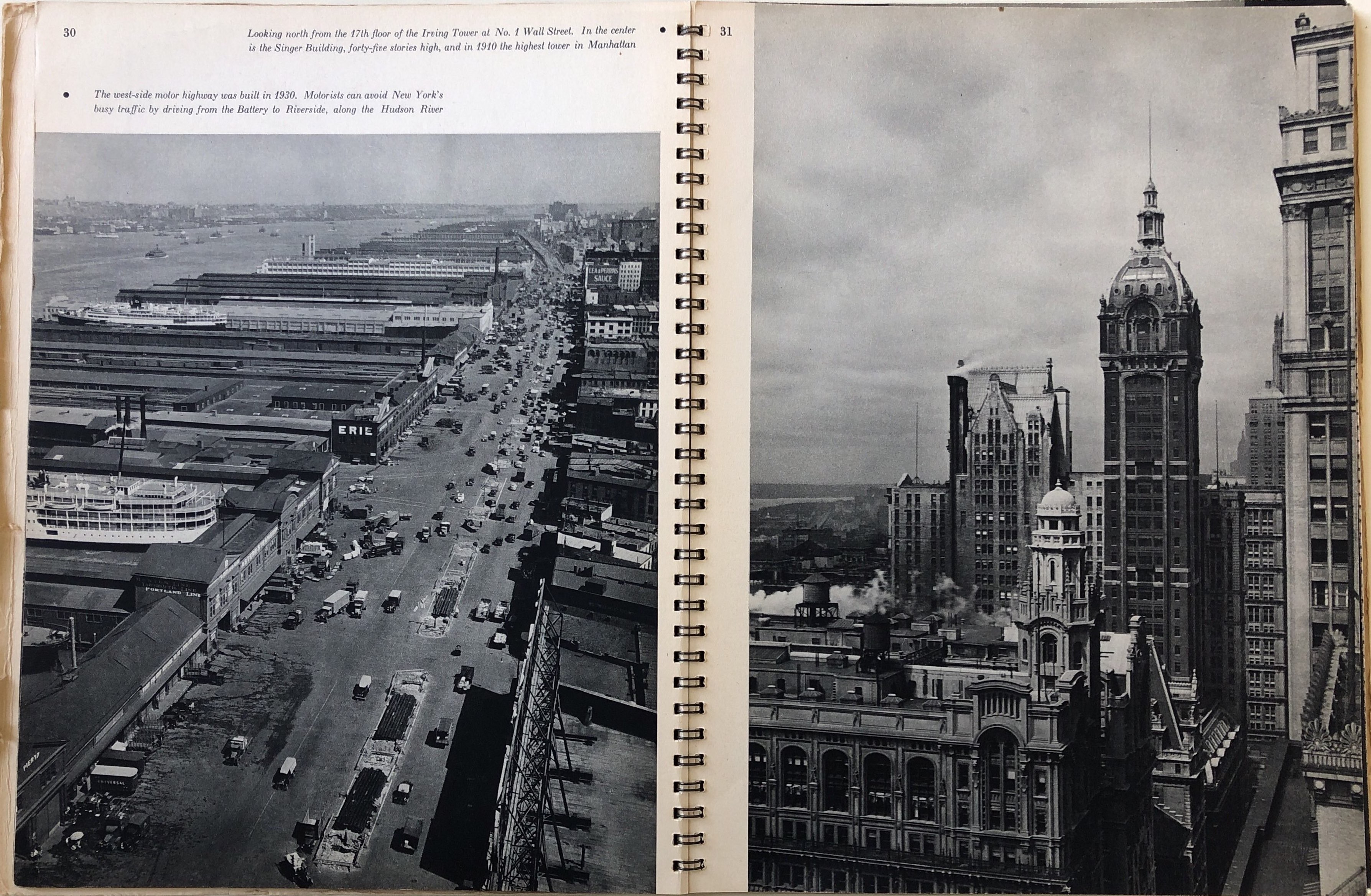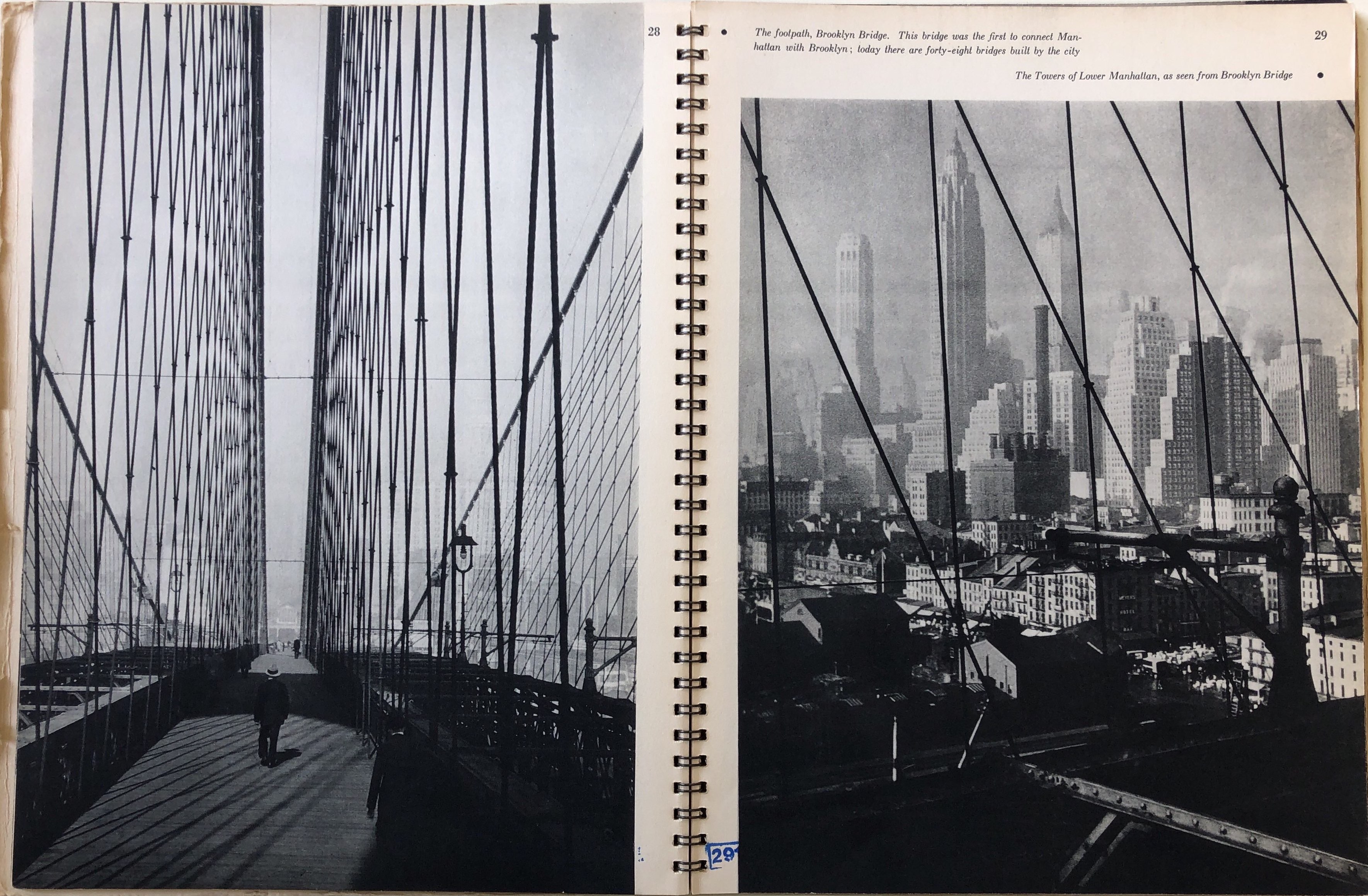Archive
Manhattan Magic. A collection of eighty-five photographs
- Photobook
- Manhattan Magic. A collection of eighty-five photographs
Word Count: 7
- Mario Bucovich
- 1937
- 1937
M.B. Publishing, 12 East 41st Street, Midtown Manhattan, New York, US
- English
23 x 30 cm (9 x 12 inch)
- New York City (US)
Manhattan Magic is a photobook which was published in 1937 by the German émigré photographer Mario Bucovich in New York City.
Word Count: 20

Cover of Manhattan Magic. A collection of eighty-five photographs by Mario Bucovich, M.B. Publishing, 1937. 
First page of Manhattan Magic. A collection of eighty-five photographs by Mario Bucovich, M.B. Publishing Company, 1937, pp. 8–9. 
“Looking from the 17th floor of the Irving Tower at No. 1 Wall Street. In the center is the Singer Building, forty-five stories high, and in 1910 the highest tower in Manhattan.” Manhattan Magic. A collection of eighty-five photographs by Mario Bucovich, M.B. Publishing Company, 1937, pp. 30–31. 
Pennsylvania and Central Station in Manhattan Magic. A collection of eighty-five photographs by Mario Bucovich, M.B. Publishing Company, 1937, pp. 46–47. 
The Brooklyn Bridge in Manhattan Magic. A collection of eighty-five photographs by Mario Bucovich, M.B. Publishing Company, 1937, pp. 28–29. 
City Hall columns and Woolworth Building in Manhattan Magic. A collection of eighty-five photographs by Mario Bucovich, M.B. Publishing Company, 1937, pp. 32–33. 
Skyscrapers shadows with a view on 60 Wall street tower and Irving Trust Company in Manhattan Magic. A collection of eighty-five photographs by Mario Bucovich, M.B. Publishing Company, 1937, pp. 18–19. 
Last page of Manhattan Magic. A collection of eighty-five photographs by Mario Bucovich, M.B. Publishing Company, 1937, pp. 46–47. Cover of Washington D.C. by Mario Bucovich, M.B. Publishing Company, 1936. Berkowitz, Michael and Todd Heidt. “The Life of Mario von Bucovich: Perils, pleasures, and pitfalls in the history of photography.” Photography & Culture, vol. 10, no. 3, 2017. UCL Discovery. Accessed 22 February 2021.
Bucovich, Marion. Manhattan Magic. M.B. Publishing, 1937.
Fernández, Horacio, editor. New York in Photobooks. RM Verlag, 2016.
Jiménez, Belén García. “Florence Henri y la mujer ibicenca.” Imatge i turisme, special issue of Estudis Baleàrics, edited by Institut d’Estudis Baleàrics, no. 94–95, 2008, pp. 47–57.
Köhn, Eckhardt. “Ich bin teuer.” Wer war Mario von Bucovich? (Fotofalle,1). Edition Luchs, 2014.
Word Count: 90
- New York
- Helene Roth. " Manhattan Magic. A collection of eighty-five photographs ." METROMOD Archive, 2021, https://archive.metromod.net/viewer.p/69/2948/object/5140-9613248, last modified: 06-02-2022.
-
Mario BucovichPhotographerEditorNew York
Only a few details are known of the life and career of émigré photographer and publisher Mario Bucovich, who, after emigrating to New York, published the photobooks Washington D.C. and Magic Manhattan.
Word Count: 33
New YorkBookPhotobookNew YorkIn 1932, after her remigration to Vienna, the Austrian journalist Ann Tizia Leitich published New York, an account of her life and writing experiences started as an emigrant in New York in the 1920s.
Word Count: 33
Chinatown U.S.A.PhotobookNew YorkChinatown U.S.A. is a photobook published by the German émigré photographer Elizabeth Coleman in 1946 focusing on American-Chinese communities in New York and San Francisco.
Word Count: 26
5th AvenuePhotobookNew York5th Avenue was the first photobook by Fred Stein and was created in 1947 with the publishing house Pantheon Books.
Word Count: 19
Pantheon BooksPublishing HouseNew YorkPantheon Books was a publishing house founded in 1942 by the German émigré Kurt Wolff (1887–1963) and aimed at the exiled European community in New York.
Word Count: 24
Fred SteinPhotographerLawyerNew YorkAlways accompanied by his camera, the German émigré photographer Fred Stein discovered New York City during the 1940s and 1950s. His pictures provide an human and multifaceted view of the metropolis.
Word Count: 31
Elizabeth ColemanPhotographerWriterEditorNew YorkThe German émigré photographer Elizabeth Coleman emigrated in 1941 to New York, where she photographed and published the photobook Chinatown U.S.A..
Word Count: 22
Black Star AgencyPhoto AgencyNew YorkThe German émigrés Kurt S(z)afranski, Ern(e)st Mayer and Kurt Kornfeld founded Black Star in 1936. The photo agency established was a well-run networking institution in New York.
Word Count: 31
PIX Publishing Inc.Photo AgencyNew YorkPIX Publishing Inc. was a photo agency founded in New York in 1935 by photo agent Leon Daniel and Celia Kutschuk, together with German émigré photographers Alfred Eisenstaedt and George Karger.
Word Count: 30
Leco Photo ServicePhoto LabNew YorkLeco Photo Service was a photofinishing lab, highly-frequented and a contact hub for émigré photographers and photo agencies during the 1930s and 1940s, as well as a provider of employment for women in the photo industry.
Word Count: 36
Oceana PublicationsPublishing HouseNew YorkOceana Publications Inc was a publishing house specialising in law and civil rights founded by the British émigré Philip F. Cohen (1911–1998) in 1945.
Word Count: 22